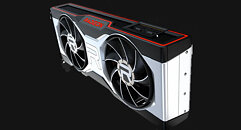Monday, February 1st 2021

AMD Radeon RX 6700 XT Confirmed to Feature 12 GB GDDR6 Memory
AMD is slowly preparing to launch its next-generation of mid-range graphics cards based on the RDNA 2 architecture. Following the launch of Navi 21 GPU SKUs, next in line comes the slower Navi 22 variant with fewer compute units (CU). Envisioned to compete against NVIDIA's GA104 and GA106 GPU SKUs, the Navi 22 based GPU is targeting 1440p gamers mainly. Today, thanks to Andreas Schilling from the German website HardwareLuxx, we got a few pieces of information regarding AMD's upcoming Radeon RX 6700 XT graphics card. The source is claiming that we are getting this card sometime in the first half of this year, with the possibility to get it in Q1.
The AMD Radeon RX 6700 XT graphics card is designed for 1440p gaming as mentioned, and its VRAM configuration is interesting. It features 12 GB of GDDR6 memory, which is more than enough for the types of workloads this card is meant for. The memory communicates using 192-bit bus. The Navi 22 GPU is configured for 40 CUs in total, with 2560 cores maximum. The Radeon RX 6700 XT features the Navi 22 XT variant with the fully enabled die, while its smaller brother Radeon RX 6700 is featuring Navi 22 XL die that has possibly fewer CUs and smaller TDP. The pricing of the upcoming cards is unknown.
Sources:
Andreas Schilling, via VideoCardz
The AMD Radeon RX 6700 XT graphics card is designed for 1440p gaming as mentioned, and its VRAM configuration is interesting. It features 12 GB of GDDR6 memory, which is more than enough for the types of workloads this card is meant for. The memory communicates using 192-bit bus. The Navi 22 GPU is configured for 40 CUs in total, with 2560 cores maximum. The Radeon RX 6700 XT features the Navi 22 XT variant with the fully enabled die, while its smaller brother Radeon RX 6700 is featuring Navi 22 XL die that has possibly fewer CUs and smaller TDP. The pricing of the upcoming cards is unknown.

40 Comments on AMD Radeon RX 6700 XT Confirmed to Feature 12 GB GDDR6 Memory
Well its only a midrange card soooo probably about 700 dollars?
By the time ray tracing becomes a more prominent aspect of gaming, we're probably going to be another 2 or 3 generations down the road in terms of GPUs and anything from this generation will still suck with ray tracing.
I would like to get my hands on a current RX 6800 or RTX 3070, just so I have a better GPU than I do that can last me 4+ years like my 980Ti has....which is actually going on it's 6th year come June. I don't care about ray tracing and I dislike DLSS. I just want a new GPU. I'd even be interested in the 6700XT if it has a performance near the 3070 or 6800 and doesn't come in with a price that rakes your eyes so bad you want to run away from PC gaming forever.
I'm building a new system and had to buy a second hand 2080 Super and will have to buy a 3700X, can't get any AMD products and wasn't going to pay $1100 for a 3070. ETA for even for Ryzen 5000 series is 2-3 months and RX prices are laughable.
Can we preorder Zen 5 and RDNA 4, thought I'd get in early to have a chance of getting them.
Thanks to (Greed) Miners / Scalpers ... did anyone check the newegg prices? 5700XT for 1400 USD :eek: RX 580 for 590 USD :kookoo:
Crazy times but maybe that situation shows everyone to focus on something else than graphics cards.I'm not even going on newegg or amazon etc. There's really no point for this and Holy Crap :O
All I said is that it just strikes me as odd that folks want ray tracing aspects in GPUs when both sides are awful at it in it's current state.
Flip on ray tracing for Nvidia, even with their RT cores that are supposed to handle it, the overall impact is still massive. Same goes for AMD's card.
Then Nvidia wants you to enable DLSS to help alleviate the loss of FPS while at the same time sacrificing image quality so they can boast how much better at ray tracing they are over AMD.....bleh, they can keep their blurry upscaling software.
That's why I say right now, ray tracing is rather a moot point (a gimmick right now in its infancy) to weigh your decision making process on a GPU from either side. Give it another couple of generations before ray tracing becomes more of the norm (more games supporting it and more efficient hardware/software to render it). 2 or 3 generations from now is when the hardware and software for ray tracing will really start to solidify and that's when you should be concerned about how well a GPU make/model handles ray tracing.